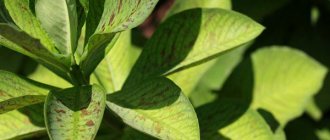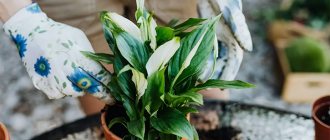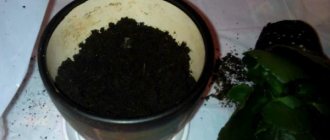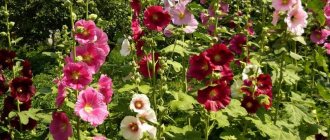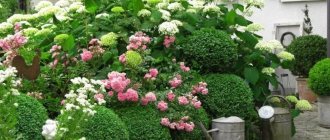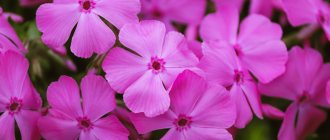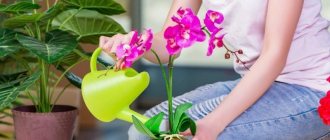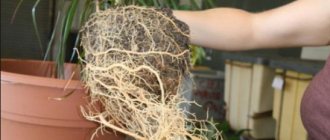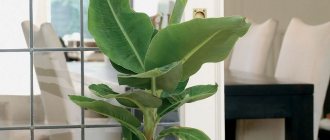Lianas - what do we know about this exotic plant, what characteristics does the plant have, is it possible to grow it at home and how to properly care for indoor lianas? We will try to answer these and other questions in this article.
10 Rules for Caring for Indoor Vines Sorry, there are no surveys available at this time.
Every day, growing exotic plants on your windowsill is gaining more and more popularity and liana is no exception. The homeland of lianas is considered to be tropical (about 2,000 varieties) and European forests, the Far East, the Caucasus, Crimea - where about 200 forms of the plant exist. They are herbaceous, evergreen or deciduous plants, perennial or annual, with herbaceous or woody stems, which reproduce rapidly by cuttings.
At home, it is customary to grow decorative indoor vines, of which there are many varieties. They fit perfectly into the home interior, rising up with ease and becoming not only a decoration for walls, but also stairs, supplies, columns, etc.
All varieties of vines, regardless of decorative or wild, have common characteristics, including the need for mandatory support, since they cannot stand on their own.
Before you get a tropical “pet” at home, learn all the intricacies of caring for it.
Flower growers prefer to grow climbing vines, since such a plant changes shape - it can be twisted, bent, or given a spiral shape. Most often, species such as ivy, monstera, hoya, bindweed, chlorophytum, clerodendron, passionflower and others are planted in indoor pots.
Whatever type of vine you choose, it requires careful and regular care; one mistake and the plant loses its appearance and attractiveness, growth slows down, and the leaves begin to wither. To avoid mistakes and grow a real beauty, you should follow the general rules for caring for indoor vines.
Individual approach
The choice of vines should be approached responsibly. To grow and maintain a presentable appearance of the plant, try to adhere to a special care program. The easiest way to monitor the condition of a flower is to hang a tag with general information (time of fertilizing, watering, replanting, humidity indicator) on the pot. This method will help to identify what the plant lacks.
The choice of vines should be approached responsibly
A distinctive feature of all decorative vines is high air humidity and diffused lighting. If the humidity in the room is low, the plant will lose leaves and there is a possibility of getting a bare stem, and if exposed to direct sunlight, the flower may get leaf burns. Considering these needs, determine a suitable location. Study all the characteristics and individual features, namely: pruning (it is individual for each subspecies), watering, replanting, fertilizing, and only with a complete understanding of the future decorative vine, buy it home.
Similar but different
Almost all types of vines come from the tropics, where the weather is warm and humid. They grow rapidly and are easily propagated by cuttings. Rooting of the plant also occurs quickly. Thanks to these advantages, such indoor plants have gained such popularity. For example, Kvamoklit, which is also called the cypress vine, is capable of growing more than 2 m during the growing season.
The general characteristics of the vines are similar to each other, but still these plants are quite different. They are flexible, may have a herbaceous stem, and sometimes become woody over time. There are also annual and perennial indoor vines. Some species are evergreen and some are deciduous.
But most species are evergreens as well as perennials. This is due to the fact that for home cultivation, species were initially selected that can be admired throughout the year and do not need to be replanted every year. Herbaceous species are grown indoors, and on the plots you can often find vines with flexible stems, or those that become woody over time.
Indoor vines are also distinguished by class. Separation occurs in accordance with the method of attaching the plant to the surface. Root-climbing vines are distinguished by the fact that they are attached by roots during growth. Plants that are attached with the help of shoots-tendrils or branches are called climbing, and also - tendril-bearing. The supporting vines will be attached using suction cups.
The most common option among gardeners is curly. Sometimes the plant is twisted so that it wraps around a decorative support. The result is a spiral-shaped plant.
Flowering varieties such as Ivy, Passionflower, Monstera and others are very popular. It is noteworthy that there are lianas among cacti.
Watering stages = development stages
The time of year and stage of growth certainly affects the need for watering indoor plants. For the liana family, a properly drawn up and timely adjusted watering schedule will help avoid withering and rotting of the plant.
For the liana family, a properly drawn up and timely adjusted watering schedule will help avoid wilting.
Water consumption depends on the period of active growth of the plant or its dormancy; the main thing is not to over-moisten the soil in order to avoid rotting of the roots and at the same time avoid drought. During the growth period, we increase watering by 2 times - as the soil dries out. The water should be at room temperature, it is better to use settled water.
Take note:
- We water the indoor vine in the morning, or at least in the evening, since daytime watering is not acceptable;
- to avoid diseases, water the plant with warm, settled water;
- when watering, we try not to wet the leaves;
- to avoid damage to the leaves and stem, water with slow pressure of water;
- We water as the top layer of soil dries, avoiding waterlogging of the soil (take into account that the soil under the leaves retains moisture longer);
- after watering, after 15-20 minutes, drain the drained water from the pan - it prevents the process of rotting of the root system;
- during active growth and at rest, depending on the season, we increase watering by 2 times, or gradually reduce it so that the plant gets used to new conditions;
- to wash away the accumulated dust on the leaves and thereby avoid the appearance of spider mites, do not forget to give the vine a shower; once a month is enough;
- decorative vines do not tolerate drought and hot air; if possible, the air should be fresh, but without drafts.
Transplantation is carried out only upon request
Only young vines are replanted annually. The older and larger the plant, especially if it is formed on supports that are difficult to transfer to other containers, the less often you will have to replant, delaying it until the roots have completely mastered the substrate.
If the vines grow quickly, the roots appear in the holes after a few months, and the plant itself does not tolerate containers that are too spacious, you should not wait for a favorable period for replanting in the new spring, but replant when and as often as necessary, up to several times a year .
Passionflower (Passiflora). © T. MA
Hygiene is important, regardless of size
Despite the numerous varieties of vines, like all other indoor plants, they require care, which includes periodic inspection of leaves (on both sides) and shoots, spraying, showering, bathing, cleaning, ventilating the room, avoiding drafts. Any deviations - dark spot, change in color, lethargy lead to the death of the plant.
Any deviations - dark spot, change in color, lethargy lead to the death of the plant
Forming vines indoors
Lianas tend to creep upward. They calmly do this without the help of a gardener. But what’s important to you is not the fact of movement itself, but how beautiful and aesthetically pleasing it looks in your apartment. To do this, you will definitely have to purchase a support. It can be either potted or one that should be attached directly to the wall. The subsequent algorithm of your actions should look like this:
- we choose the shoots that we want to pick up;
- we pinch them where the apical stem is located;
- We wait for lateral shoots to appear on the shoot after pinching.
Micro and macroelements are equally important
For growth and beautiful appearance, like all house plants, vines need regular feeding. Ornamental vines are fed on average once every 2 weeks, and during the growth period the frequency of feeding increases.
For growth and beautiful appearance, like all house plants, vines need regular feeding.
If the plant was planted recently, do not rush to feed it, give it time to adapt and strengthen the roots. Fertilizer for vines is chosen in such a way that micro- and macroelements are suitable specifically for your “pet”. A complex fertilizer is optimally selected, which includes: calcium - necessary for growth and formation of shoots, magnesium - responsible for the uniform coloring of leaves, iron - improves the quality of leaves, as well as phosphorus, potassium, nitrogen, manganese, sulfur, copper, etc. This It could be ammonium nitrate, urea or liquid fertilizer, which can be found in specialized stores; also, fertilizer prepared independently and diluted in water will be a good fertilizer for indoor plants.
If your choice is liquid fertilizer, dilute it according to the instructions, otherwise, with a high concentration of the substance, the vine may get burnt to the root system. It is recommended to infuse self-prepared fertilizers well before use (bird droppings, mullein, tops of cultivated plants, compost are suitable at a ratio of 1:2, where 1 is dry matter and 2 is water; mix well, cover with a lid and leave for 3-4 days, dilute the resulting slurry with water in a ratio of 1:4 and water the soil).
Propagation of indoor vines
The cut cuttings can be placed in a container of water to allow roots to appear. But Ivy and some other species can be immediately planted in the ground. Because they have aerial roots.
To make rooting happen faster, the cut can be processed. There is a special remedy - “Kornevin”. But you can also use folk remedies. For example, aloe juice.
Sometimes vines are propagated using seeds. Passiflora grows very well from seeds. The escape turns out to be quite strong. Difficulties may arise with other species, so propagating them by seeds is not recommended.
Sometimes a method such as dividing a bush is used to propagate indoor vines.
A healthy vine starts with a quality substrate
Selecting soil for home vines is not difficult, the main thing is to adhere to several criteria. The soil should be: light, fertile, nutritious, loose, water- and breathable (in this case, a ready-made mixture - “Begonia” or “Cactus-plus”) is suitable); alternatively, use a turf mixture or humus. The composition of the substrate is selected according to the root system - light for young and thin roots, medium for fast-growing ones and heavy for large vines with large roots. It doesn’t hurt to add charcoal, ash, expanded clay, etc. to the soil for the purpose of disinfection. Good and high drainage in the pot will promote the development of the vine and help avoid many problems.
How to grow a vine to decorate your home
These plants can be successfully used to decorate rooms in a house or apartment. Indoor vines can add style and originality to any room. Indoor vines look great next to the fireplace, in kitchens, in offices, on stairs and in doorways. Their use allows for many design moves. At home, trellises or ropes are used to support the stems of vines.
Jasmine
Household vines differ in their maintenance conditions. Some need sunlight, others can grow in darker conditions. Consider these factors before choosing one.
The most unpretentious indoor flower is aeschynanthus; it feels great at room temperature from 15 to 30 degrees and loves diffused sunlight. Jasmine is a strongly scented vine that requires at least four hours of direct sunlight per day and consistently moist soil.
Climbing plants should be planted in a soil mixture with sphagnum moss, vermiculite, perlite and sand, or at least in a mixture with peat moss and perlite. Pots must be equipped with drainage saucers. As a rule, indoor flowers require lighted areas with moderate exposure to the sun.
Rooms with large windows in the southern part of the house or apartment are especially suitable. During hot sunny hours, shade should be used to prevent them from burning.
Aeschynanthus beautiful
Transplantation must be carried out with extreme caution
Having chosen a decorative vine in flower shops, the plant must undergo acclimatization and get used to the new place. After 2 weeks, the new plant is transplanted into a new pot, avoiding damage to the roots. The best way is to carefully transfer the vine along with the soil, without breaking the shoots and leaves, into another pot. When replanting a large plant, we recommend using additional hands to cope with the heavy rhizome and soil without damaging the vine. The day before replanting, water the vine, this will help pull the root out of the previous container.
Having chosen a decorative vine in flower shops, the plant must undergo acclimatization and get used to the new place
If there is a need to replant a large plant and you decide to replace the entire soil, carefully loosen it, this will help free the root from the old soil. Damaged or dry roots should be removed or trimmed; wounded roots should be treated with a solution of potassium permanganate. We plant the plant in the center of the pot so that in the future the plant does not lose stability. We pour the soil lightly, do not forget that the indoor vine loves loose soil.
Loosening, as for garden plants
For indoor vines, you need to periodically loosen the soil, preventing compaction and maintaining optimal air and water permeability. It is especially important to renew the structure of the upper soil layer of the substrate for large plants that are not replanted annually.
Over time, in the absence of loosening, actively growing vines suffer not only from compaction and even crusting of the soil, but also from its contamination. With regular loosening, problems with soil condition can be prevented, and plant debris can be removed in a timely manner. Loosening the substrate for indoor vines has its own rules:
- it is carried out superficially, to a depth of no more than 1.5 cm;
- You need to loosen the soil very carefully, near the walls of the pot, making sure not to touch either the shoots or the roots of the plant.
Stephanotis. © jmchapp
Gentle handling is the most important thing after transplantation
After transplanting, the home beauty is watered generously in small portions to evenly moisten the soil. The watering schedule is approached gradually. To avoid injury to the roots and slower growth, you should not add fertilizer for 1-1.5 months, since when transplanting there are enough nutrients in the soil that are so important for the plant.
Do not leave the vine near heating appliances, avoid direct exposure to sunlight. Air humidity should be high and be about 60%. When the plant adapts, check the condition of the leaves and new shoots and feel free to return the vine to its usual place.
Air humidity directly determines the condition of the leaves
Indoor vines have a very large vegetative mass. A huge number of shoots and leaves leads to the fact that the plant becomes more sensitive to deviations in air humidity from comfortable levels. While changes in humidity and short periods of dry air can be compensated for in other plants, vines usually react immediately, from drying out the tips of the leaves to disrupting growth. The more moisture-loving the vine, the more carefully you need to control the indicators.
For all vines without exception, except for species with pubescent leaves, spraying is a mandatory item in care. By refreshing the leaves and increasing humidity, it also saves the plants from overheating and allows them to more fully compensate for the rate of moisture evaporation. Lianas are always sprayed in the morning and never in the sun.
Spraying is carried out only when kept at room or higher temperatures. For vines that do not tolerate dry air, spraying alone is not enough. They can be supplemented or replaced by installing humidifiers - trays with wet moss or expanded clay, special devices.
Cissus. © hopefulauthor
Landing location
Climbing vines will be much happier in sunny areas and well-drained soil.
In this case, a mandatory condition will be the presence of support nearby. These can be purchased or self-made arches, fences or walls of garden houses, outbuildings, bathhouses or gazebos.
But when decorating the surface of buildings when planting perennial vines, it is necessary to retreat from the walls by at least half a meter. Firstly, this will make it possible to preserve the foundation from strong roots, and, secondly, it will allow the young sprout to normally move to a new place.
Blooming perennial vines
Clematis, capmsis, wisteria, petiolate hydrangeas, climbing honeysuckle and climbing roses will delight you with bright flowers. They can create a charming corner that imitates the ancient castle of the Sleeping Princess or the lush Mediterranean landscapes.
But such plants will require additional care.
Benefits of garden vines
Such plants will not take up much land, so they will be an excellent addition to areas lacking large spaces. They will gracefully decorate the most unassuming fence, visually enlarging the territory and gently delighting their owners with foliage, they will cover old or shabby buildings, turning them into charming houses of forest fairies or hardworking gnomes.
Green plantings can create an optimal microclimate in a particular area. In this case, capricious plants can be planted next to the growing vines.
Arches and pergolas entwined with vines will quickly transform the area into some kind of Mediterranean courtyard. And the berries that decorate some types of vines will be a good addition to the autumn harvest abundance.
Lianas will be a completely inexpensive purchase; for the most part, they are undemanding to care.
Decorative perennial vines
Pretty and elegant perennials include ivy (by the way, it will delight its owners even in winter), virgin grapes, wood pliers, and hops.
Application of decorative vines
Perennial vines for the garden will become a beautiful decoration for the walls of any buildings, a living fence separating the yard from the street or neighbors, a green hedge dividing the garden into zones.
Even the most boring garden will become a charming place to relax if you plant nice decorative or useful fruit-bearing vines on it.
